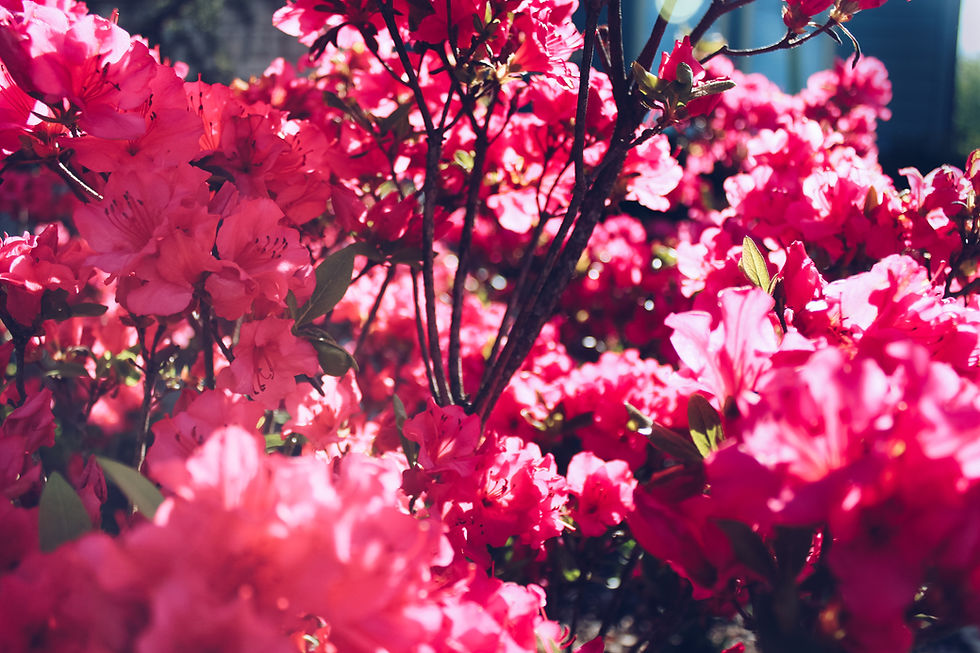July Garden "To-Do" List
- flockelsihadcock
- Jul 16, 2020
- 4 min read
The summer months in Southeast Texas are very hot and very humid. It is an easy time to give up on your yard. Each month we will add a suggested “to do” list specifically designed for this area that will help keep your yard in tip top shape. These suggestions will help you keep your yard eye pleasing and a delightful place to spend some of your summer days.

Annuals: An annual is a plant you plant once a year and only live for one growing season. Some examples of annuals are: petunias, sweet peas and zinnias. In order to keep your annuals looking perky and pretty you will need to apply fertilizer such as blood meal or annual fertilizer.
*If you have not planted your annuals it is not too late! Make sure you pick annuals that can withstand hot humid climates. Such as:

Azaleas: This is the time of year to take a look at your azaleas. Azaleas do very well in Southeast Texas and in the spring fill our yards with beautiful blankets of pinks, purples, and whites. Think about if your azaleas failed to bloom well this year. If so, you may need to love above the azaleas to ensure that during the months of July and August the plants are getting enough sunlight.

Beds: In between seasons is a great time to clean up your beds and/or alter the design of the bed if desired. Cleaning up the beds includes: pruning shrubs, brush back leaves and any other dead debris, pull up any dead plants, pull weeds and edge garden beds. This is a great time to start preparing your list of bulbs and plants you would like to plant for next year.

Lawns: Lawn care can be tricky in the summer due to the high heat and sometimes intense or too little rain we receive in Southeast Texas. Check for brown spots in your lawn. The brown spots could indicate too much or too little water. The brown spots may also suggest you some unwanted insect guests have made a home in your yard. Chinch bugs and grubs are often the culprits of dead spots in your lawn. Here is a great video to determine if you chinch bugs are present in your lawn. Click here to view video You might also want to check to see if your lawn has grubs. Here is a great video to determine if there are grubs in your yard. Click here to view video Continue to cut your lawn as needed and be careful not to cut it too short. St Augustine grass should be cut to about two and half inches high. Also continue to water your lawn regularly. Finally, summer is an excellent time to feed your lawn. Some examples of lawn food are: Scotts Green Fertilizer, Miracle Grow Lawn Food or Scotts Turf Builder.

Bluebonnets: If you have bluebonnets that have dried out and have already reseeded themselves, then this is the time to pull up the dead plants. You can tell if the bluebonnets have reseeded themselves by looking at the plant to see if the seed shells have popped open.

Roses: This is a great time to prune and cut back your roses. Pruning controls the size and shape of the roses. It also helps your roses to bloom continuously through the summer. Hybrid teas, floribundas, and grandifloras need major pruning during this time. Here is a great video on how to prune your rose bushes. Click here to view video It would also be wise to fertilize your roses during this time. Some great fertilizers you might use are Miracle Grow, Bayer or Scotts brand rose fertilizers.

Mulch: After cleaning your flower beds out, you might want to use flower bed mulch. Flower bed mulching keeps weeds at bay and helps protect plant roots. It also helps keep the soil moist and prevents it from washing away. Mulch also makes your beds look more unified and aesthetically pleasing. Make sure you are using shredded bark rather than grass clippings and leaves. If you would rather use the clippings and leaves they need to be composted first.

Watering: Bougainvillea, geraniums, moonflowers, morning glories are among plants that like dryish soil, so be careful not to over water these plants. Here is a great video about over watering plants. Click here to view video During high heat times potted plants may need watering once or twice daily. Oftentimes plants tend to look as if they are wilting in the noon day sun. This does not signify dryness, but wilting in the early morning or late afternoon does indicate they need to be watered due to dryness. When watering, set your hose to a fine mist. Plants benefit from spraying on the foliage but not during the heat of the day. Finally, always water before and after feeding.

Pests: Pests can come in all forms and fashion. Here are a few to be on the lookout for: scale insects (resembling small white round scabs on the leaves); mealy bug (cotton like insect on steam and under side of leaf) During this time you will need to spray a SUMMER oil spray in dilution and that is suitable for hot weather. Be Careful because some sprays may burn foliage in very hot weather, causing defoliation. This is a great article about insect control. Click here for article

Comments